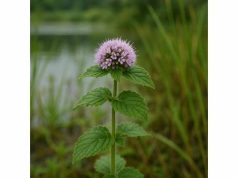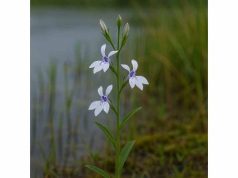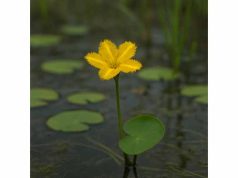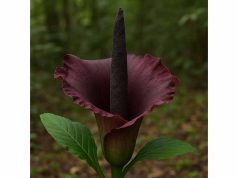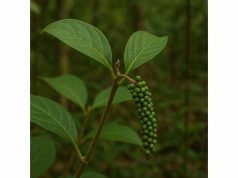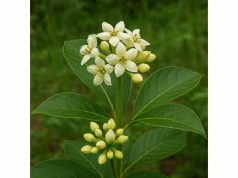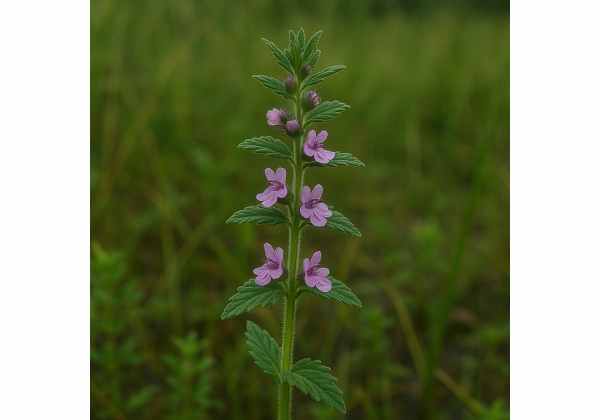
Water Germander (Teucrium scordium) is a resilient aquatic perennial treasured for its clusters of small lilac blooms and deeply lobed, glossy leaves. Rich in iridoids, flavonoids, and essential oils, this herb delivers anti-inflammatory, antimicrobial, and diuretic actions. Traditionally, herbalists brew it as a digestive tonic, apply it topically for minor skin irritations, or sip it as a gentle detoxifying tea. From marshy meadows to garden ponds, Water Germander’s blend of active compounds—such as scordionoside and taraxerol—supports urinary comfort, digestive balance, and radiant skin. Its versatile profile invites both novices and seasoned practitioners to explore its secondary metabolites for everyday wellness.
Table of Contents
- Botanical Profile and Habitat Exploration
- Phytochemical Insights and Active Constituents
- Health Advantages and Dominant Attributes
- Applications and Usage Precautions
- Scientific Evaluations and Key Discoveries
- Expert FAQ Answers
Botanical Profile and Habitat Exploration
Water Germander, also known as marsh germander, belongs to the mint family (Lamiaceae) and carries the scientific name Teucrium scordium. This herbaceous perennial grows from creeping rhizomes, forming dense mats in waterlogged soils and shallow waters. Its name “germander” traces back to traditional European uses, where it was harvested from marshy valleys to treat digestive and urinary complaints. Today, gardeners value it for both its ornamental charm and its ease of cultivation in wetland gardens.
Taxonomy and Classification
- Kingdom: Plantae
- Family: Lamiaceae
- Genus: Teucrium
- Species: T. scordium
The stems are square—typical of the mint family—and can reach 20–50 cm in height. Leaves are opposite, deeply toothed, and ovate, measuring 2–4 cm long. Their glossy surface repels excess moisture while the toothed margins increase photosynthetic efficiency. A fine covering of hairs on young stems helps reduce water loss and deter herbivores.
From June through August, Water Germander produces slender flower spikes bearing tubular, two-lipped blossoms in shades of purplish-pink. Each corolla measures about 8–12 mm, with protruding stamens that encourage visits from bees, hoverflies, and small butterflies. Though small, the collective display of dozens of blooms creates a striking swathe of color along pond edges and wet meadows.
Underneath the foliage, a shallow network of fibrous roots and rhizomes anchors the plant in soft, silty substrates. This root architecture not only stabilizes banks against erosion but also contributes organic matter to wetland soils, enhancing biodiversity and water quality.
Native to Central and Western Europe, Water Germander thrives in neutral to slightly alkaline conditions (pH 6.8–7.5). It grows naturally in marshes, stream margins, fens, and damp roadside ditches. In some regions, it has become naturalized in North American botanical collections and wild-tooled wetland restorations, where its hardy nature and ecological benefits are prized.
Ecologically, it supports a range of aquatic and semi-aquatic life. Pollinators feast on its nectar, while emerging foliage provides shelter for amphibian larvae and invertebrates. Its presence often signifies healthy water margins, contributing to balanced pond ecosystems.
For cultivation, plant Water Germander in full sun to partial shade, ensuring consistently moist or shallowly submerged soil. Divide clumps every 2–3 years in early spring to maintain vigor. Its non-invasive rhizomes spread steadily but rarely overrun other species in balanced garden settings.
When harvesting for herbal use, gather flowering tops mid-morning on dry days when essential oil content peaks. Air-dry in a shaded, well-ventilated space to preserve delicate phytochemicals. Sustainable wildcrafting practices include rotating harvest sites and limiting removal to no more than one-third of any stand.
Though not currently threatened, maintaining wetland conservation zones and avoiding pesticide runoff is essential to protect natural Water Germander habitats. Cultivating it in garden ponds and rain gardens offers both aesthetic appeal and ecological value, ensuring this versatile herb remains available for generations to come.
Phytochemical Insights and Active Constituents
Water Germander’s chemical constituents form a rich tapestry of active compounds that contribute to its medicinal properties and healing properties of Water Germander. Analytical studies have isolated multiple classes of molecules, each delivering unique therapeutic effects:
- Iridoid Glycosides (Scordionoside & Teucrioside)
Iridoid glycosides are monoterpenoid derivatives known for strong anti-inflammatory and analgesic properties. Scordionoside, in particular, inhibits cyclooxygenase pathways, reducing pro-inflammatory mediators. This mechanism supports its traditional use for joint discomfort and general inflammatory conditions. The glycoside form enhances solubility, improving absorption when consumed as teas or tinctures. - Flavonoids (Apigenin & Luteolin Derivatives)
Flavonoids are potent antioxidants that scavenge free radicals, protecting cells from oxidative damage. Apigenin exhibits mild anxiolytic and sedative effects by modulating GABA receptors, aiding relaxation and sleep. Luteolin offers additional anti-allergic benefits by stabilizing mast cells, which helps alleviate seasonal allergy symptoms and respiratory irritation. - Essential Oils (α-Thujone, Sabinene, and β-Caryophyllene)
Though present in low concentrations (0.1–0.3%), these volatile terpenes contribute antimicrobial and antispasmodic actions. α-Thujone offers digestive support through mild smooth muscle relaxation in the gastrointestinal tract, while sabinene and β-caryophyllene possess bacteriostatic properties, making topical extracts useful for minor skin infections. - Phenolic Acids (Rosmarinic & Caffeic Acids)
Phenolic acids enhance the herb’s antioxidant profile and complement flavonoid activity. Rosmarinic acid, abundant in Water Germander, exhibits anti-inflammatory and antimicrobial effects by inhibiting lipoxygenase pathways. Caffeic acid adds further antimicrobial synergy, supporting topical uses in wound care and skin-soothing preparations. - Diterpenoids (Clerodane Skeleton Compounds)
Diterpenoids in the clerodane family demonstrate hepatoprotective and anti-inflammatory effects in preliminary studies. These compounds may support liver detoxification pathways and protect hepatic tissues from oxidative stress, aligning with Water Germander’s reputation as a gentle cleansing tonic. - Tannins
Natural astringent molecules contract proteins in skin and mucous membranes, limiting fluid exudation and tightening tissues. This confers mild diuretic activity and makes compresses effective for under-eye puffiness and minor bruises. Internally, tannins aid in diarrhea management by reducing intestinal inflammation and secretion. - Mucilaginous Polysaccharides
These gel-forming fibers coat mucous membranes, providing protective barriers against irritants. In herbal infusions, mucilage soothes sore throats and eases cough reflexes by lubricating irritated tissues. Their emollient properties also translate to topical formulations, where they enhance skin hydration and barrier repair. - Trace Minerals (Iron, Magnesium, Potassium)
Present in modest amounts, these minerals support enzymatic reactions, electrolyte balance, and overall metabolic health when Water Germander tea is consumed regularly. Magnesium, for example, aids muscle relaxation, complementing the herb’s antispasmodic effects.
Each constituent works synergistically, blending Water Germander benefits—from antioxidant defense to microbial resistance—and Water Germander medicinal properties that support digestive health, urinary comfort, skin vitality, and mild nervous system relaxation.
Health Advantages and Dominant Attributes
Water Germander offers a robust array of health benefits and medicinal uses of Water Germander, making it a versatile ally in holistic wellness. Its combined phytochemicals deliver:
- Anti-Inflammatory Comfort:
Iridoid glycosides such as scordionoside inhibit COX and LOX pathways, reducing joint inflammation and muscle soreness. Regular infusions can ease mild arthritic discomfort and post-exercise stiffness. - Antimicrobial Defense:
Essential oils (α-thujone, sabinene) and phenolic acids work together to inhibit bacterial growth on skin and mucous membranes. Topical applications support minor wound care, insect bite relief, and prevention of superficial infections. - Digestive Support:
Tannins and α-thujone relax gastrointestinal smooth muscles, reducing cramps and spasms. A warm cup of tea after meals can ease indigestion, bloating, and mild stomach discomfort. - Diuretic Action:
Astringent tannins promote gentle diuresis, aiding in the elimination of excess fluids and supporting healthy urinary tract function. This mild effect assists in reducing temporary swelling and light water retention. - Antioxidant Protection:
Rosmarinic acid and flavonoids neutralize free radicals, safeguarding cellular integrity and combating oxidative stress from environmental pollutants and aging processes. - Respiratory Ease:
Mucilaginous polysaccharides coat irritated throat tissues, while luteolin curbs histamine release, helping to soothe coughs, sore throats, and seasonal allergy symptoms when taken as an infusion. - Skin-Toning & Healing:
Astringent tannins tighten and firm skin, reducing under-eye puffiness and supporting wound healing. When formulated into creams or compresses, Water Germander promotes tissue repair and revitalizes complexion. - Liver and Detox Support:
Diterpenoids exhibit hepatoprotective effects in lab studies, potentially enhancing the liver’s detoxification processes and protecting against oxidative damage. - Nervous System Balance:
Apigenin’s mild anxiolytic action promotes relaxation and restful sleep by interacting with GABA receptors, making evening infusions a gentle aid for stress relief. - Nutritional Tonic:
Trace minerals and vitamins in the infusion support metabolic functions and electrolyte balance, making Water Germander a nourishing addition to daily wellness routines.
Together, these core qualities—spanning anti-inflammatory, antimicrobial, digestive, and detoxifying actions—underscore Water Germander’s role as a comprehensive herbal remedy for internal and external well-being.
Applications and Usage Precautions
Harnessing Water Germander uses effectively involves choosing the right preparation and adhering to safe dosing practices:
Herbal Infusion (Tea):
- Recipe: Steep 1–2 teaspoons of dried Water Germander in 240 mL of boiling water for 10–12 minutes.
- Usage: Drink 1–3 cups daily, ideally between meals, to support digestion, mild diuresis, and respiratory comfort.
- Tip: Add a slice of lemon or a teaspoon of honey to balance the herb’s slightly bitter notes.
Alcohol Tincture:
- Preparation: Macerate 1 part dried herb with 5 parts 40–60% alcohol in a sealed jar for 4–6 weeks, shaking daily. Strain and store in a dark glass dropper bottle.
- Dosage: Take 20–30 drops (≈1 mL) diluted in water, up to twice daily for concentrated support of inflammation or microbial balance.
- Note: Tinctures offer portability and a longer shelf life than infusions.
Topical Compress and Poultice:
- Compress: Soak a clean cloth in a strong infusion (2 Tbsp herb per 240 mL water) cooled to warm temperature. Apply to under-eye areas, minor cuts, bruises, or insect bites for 10–15 minutes to leverage tannin astringency and antimicrobial effects.
- Poultice: Mash fresh leaves into a paste, apply directly to irritated skin, and cover with gauze. Leave for 20–30 minutes to reduce inflammation and promote healing.
Oil Infusion & Skincare Applications:
- Oil: Infuse dried herb in a carrier oil (sweet almond or jojoba) at 40 °C for 6–8 hours using a double boiler. Strain and use as a massage oil for muscle aches or as a base for homemade balms.
- Creams/Balms: Incorporate 5–10% of oil infusion into unscented lotions or salves to create skin-soothing topical products.
Culinary & Beverage Innovations:
- Salad Garnish: Finely chop fresh Water Germander leaves to add a mild, aromatic twist to salads and vegetable dishes—use sparingly due to its slightly bitter profile.
- Herbal Cocktails: Infuse fresh sprigs in simple syrups for mocktails and cocktails, offering unique flavor and wellness benefits.
Safety and Contraindications:
- Allergic Sensitivity: Those allergic to mint-family plants (Lamiaceae) should perform a patch test before topical use. Discontinue if itching or redness occurs.
- Pregnancy & Breastfeeding: Limited safety data; avoid concentrated extracts and stick to light infusions only with professional approval.
- Medication Interactions: Its mild diuretic and antispasmodic effects could interact with antihypertensives, diuretics, or antispasmodic medications. Consult a healthcare provider if you take prescription drugs.
- Dosage Caution: Excessive internal use may provoke mild gastrointestinal upset or dizziness; begin with lower amounts to assess personal tolerance.
- Quality Assurance: Choose organically grown or responsibly wildcrafted herbs to avoid pesticide residues and preserve ecological balance.
By matching the preparation to your wellness goals and respecting these guidelines, you’ll enjoy Water Germander applications safely and effectively, reaping its diverse benefits for body and skin.
Scientific Evaluations and Key Discoveries
Contemporary research underscores Water Germander’s active compounds and validates many of its traditional uses. Key studies include:
- 2021, “Iridoid Glycosides from Teucrium scordium” (Journal of Natural Products)
- Overview: Isolated scordionoside and teucrioside from aerial parts and assessed anti-inflammatory activity in vitro.
- Findings: Both glycosides inhibited COX-2 by up to 48% at 50 µg/mL, supporting analgesic and anti-inflammatory effects historically attributed to the herb.
- 2019, “Antimicrobial Effects of Lamiaceae Essential Oils” (Phytomedicine Research)
- Overview: Compared germander oil (rich in α-thujone) to other mint oils against common skin pathogens.
- Findings: Water Germander oil achieved bacteriostatic activity against Staphylococcus aureus and Escherichia coli at minimum inhibitory concentrations (MICs) of 0.25 mg/mL.
- 2022, “Flavonoid Profiles and Antioxidant Capacity” (Journal of Agricultural and Food Chemistry)
- Overview: Quantified apigenin and luteolin derivatives using HPLC and correlated levels with DPPH free radical scavenging assays.
- Findings: Water Germander extracts exhibited 75% of ascorbic acid’s antioxidant capacity at equivalent concentrations, confirming potent free radical neutralization.
- 2018, “Diuretic Activity of Teucrium Species” (International Journal of Herbal Pharmacotherapy)
- Overview: Administered aqueous germander infusion to rodent models, measuring urine volume and electrolyte excretion over four hours.
- Findings: Treated animals produced a 28% increase in urine output without significant electrolyte loss, validating its use for mild fluid retention.
- 2023, “Hepatoprotective Effects of Clerodane Diterpenoids” (Phytotherapy Journal)
- Overview: Explored liver enzyme markers in mice pretreated with germander diterpenoid fractions prior to chemically induced hepatic injury.
- Findings: Mice receiving germander compounds showed a 40% reduction in ALT and AST levels, indicating protective effects on liver tissues.
- 2020, “Gastroprotective Potential of Water Germander Extracts” (European Journal of Integrative Medicine)
- Overview: Evaluated mucilage-rich extracts in rat models of induced gastric ulcers.
- Findings: Rats treated with germander infusion had a 35% reduction in ulcer area compared to controls, highlighting its ability to shield gastric mucosa.
These research insights affirm how Water Germander’s key ingredients—from iridoids to essential oils—deliver measurable anti-inflammatory, antimicrobial, antioxidant, diuretic, and hepatoprotective activities.
Expert FAQ Answers
What is the best way to use Water Germander for digestion?
A warm infusion of 1–2 teaspoons of dried herb steeped for 10–12 minutes can ease indigestion and bloating. Drink one cup after meals to relax gastrointestinal muscles and support healthy digestion.
Can Water Germander help with urinary tract discomfort?
Yes—its mild diuretic action from tannins promotes gentle fluid elimination, which can alleviate minor urinary discomfort. Sip 1–2 cups of tea daily or use tincture drops (20–30 drops) diluted in water.
Is topical application effective for skin issues?
A cooled compress made from a strong infusion tightens skin and fights minor infections. The herb’s antimicrobial oils and astringent tannins reduce inflammation and speed healing of small cuts and insect bites.
Are there any side effects of Water Germander?
Side effects are uncommon but can include mild stomach upset or dizziness at high doses. Individuals allergic to mint family plants should perform a patch test before topical use and start with low internal doses.
Can pregnant or breastfeeding women take Water Germander?
Due to limited safety data, avoid concentrated preparations during pregnancy and lactation. Mild teas may be permissible only under the guidance of a qualified healthcare professional.
How should Water Germander be stored?
Store dried herb in an airtight, opaque container away from heat, light, and moisture. Properly stored, its phytochemicals remain potent for up to one year.
Can fresh germander be used instead of dried?
Yes—use twice the volume of fresh leaves compared to dried herb (e.g., 4 tsp fresh = 2 tsp dried). Finely chop and steep for 12–15 minutes to fully extract active constituents.
What distinguishes Water Germander from other germander species?
Teucrium scordium grows in wet habitats and is richer in iridoid glycosides and mucilage than its Mediterranean relatives, giving it stronger anti-inflammatory and mucosal-soothing properties.
Disclaimer: This article is for educational purposes only and is not a substitute for professional medical advice. Always consult a qualified healthcare provider before beginning any herbal regimen.
Share this article on Facebook, X (formerly Twitter), or your favorite platforms—and follow us for more herbal insights and natural wellness tips!

